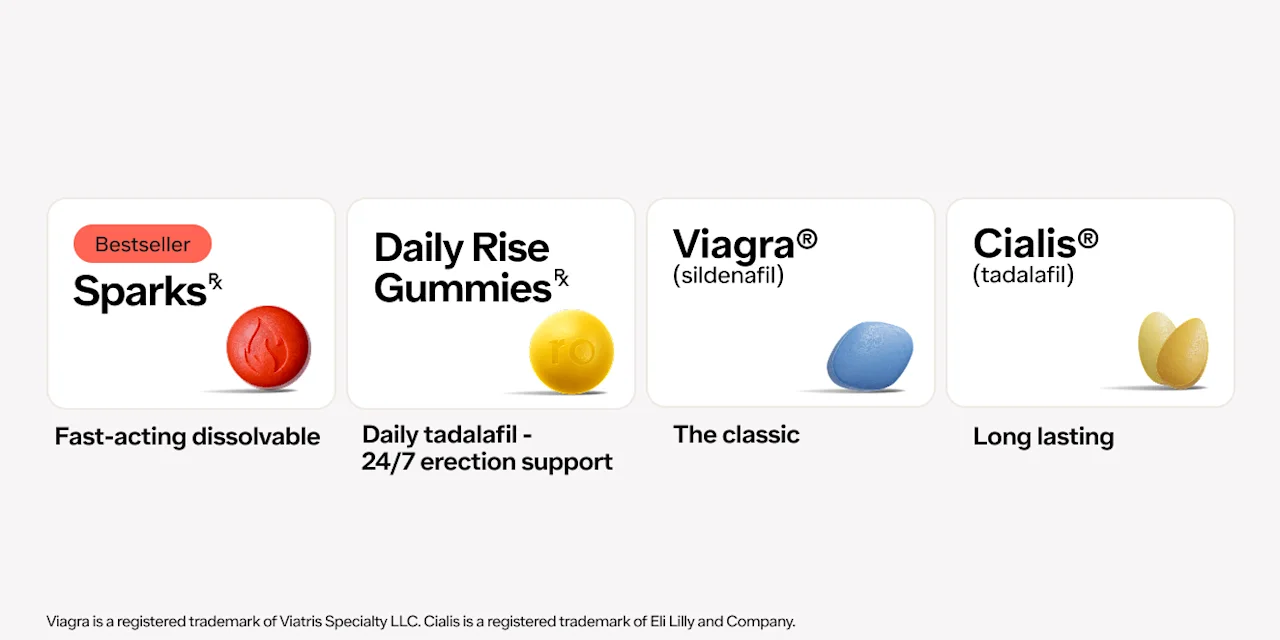Here's what we'll cover
Here's what we'll cover
If you’ve ever done an internet search on erectile dysfunction (ED) treatment options, you’ve likely run into multiple names of medicines, such as Viagra, Cialis, Levitra, and Stendra—not to mention, their generic equivalents (sildenafil, tadalafil, vardenafil, and avanafil, respectively). These are all phosphodiesterase type 5 (PDE-5) inhibitors, but getting a handle on which one is right for you can be challenging.
So, we’ve broken down the major differences between Viagra vs. Cialis vs. Levitra vs. Stendra (say that five times fast!). Read on to learn more about these PDE-5 inhibitors, including why they’re popular choices for treating ED.
But first, a quick note: While Levitra has been discontinued, the brand name is still commonly associated with vardenafil. So, for the sake of this article, we’re going to continue using Levitra—just keep in mind that only generic vardenafil is on the market today.
What are PDE-5 inhibitors?
Phosphodiesterase type 5 (PDE-5) inhibitors are prescription medications that can effectively treat several conditions, such as pulmonary arterial hypertension and benign prostatic hyperplasia (BPH). However, they are most commonly known for their treatment of erectile dysfunction (ED).
Briefly, ED is sexual dysfunction characterized by trouble getting or keeping erections long enough for satisfying sex. Some people with ED may even notice a loss of morning erections.
ED is a common experience, affecting over half of American men between 40–70 years of age. If your healthcare provider recommends a prescription medication to improve your erectile function, it is typically one of the PDE-5 inhibitors.
How do PDE-5 inhibitors work?
While erections may seem simple, they involve a surprisingly complicated process.
In order for an erection to occur, you first need to get aroused (kind of obvious, but worth repeating!). A simple summary of how erections work: Once turned on, a messenger called cyclic guanosine monophosphate (cGMP) tells the blood vessels in the penis to relax. This allows for increased blood flow into the penis; because the veins that typically drain blood from the penis contract, the blood gets trapped, which promotes an erection.
An erection ends due to the enzyme phosphodiesterase-5 (PDE-5) breaking down cGMP, which cuts off or terminates the signal to maintain an erection. This is where PDE-5 inhibitors come in. As their name implies, PDE-5 inhibitors, well, inhibit the PDE-5 enzyme, thereby stopping the breakdown of cGMP and allowing penile blood vessels to stay dilated and your erection to last longer.
But it’s important to remember that PDE-5 inhibitors are not magic pills. They cannot make an erection appear from thin air. You need sexual stimulation and arousal to start the erection process. PDE-5 inhibitors then help nature maintain the desired course.
Types of PDE-5 inhibitors
As mentioned, these drugs treat several different conditions. However, we will focus on the ones used to treat erectile dysfunction.
Examples of PDE-5 inhibitors (and their generic counterparts) include:
Vardenafil (formerly available as Levitra)
Stendra (avanafil)
The generic versions work just as well as the brand-name ones and, in most cases, are less expensive. Check with your healthcare provider and insurance provider to best determine the prices of Viagra vs. Cialis vs. Levitra vs. Stendra.
Viagra vs. Cialis vs. Levitra vs. Stendra: the basics
Viagra (sildenafil)
Viagra is the brand name for sildenafil citrate and is the first PDE-5 inhibitor approved by the US Food and Drug Administration (FDA) to treat ED back in 1998. Both the generic (sildenafil) and brand-name (Viagra) versions come in 25 mg, 50 mg, and 100 mg oral tablets while sildenafil is also available in 20 mg. The maximum recommended dose for Viagra is 100 mg per day.
How to take it and how long it lasts: Ideally, Viagra should be taken 30–60 minutes before you plan to have sex. While it can technically be taken with or without food, Viagra might take longer to kick into action if it’s consumed alongside a heavy, high-fat meal. The medication usually takes around an hour to work and typically lasts in your body for up to 4–5 hours. But your age, health, and diet can affect the exact amount of time it will work.
Common side effects:
Headaches
Facial flushing
Indigestion/heartburn
Back pain
Stuffy nose
Nausea
Cialis (tadalafil)
Cialis (tadalafil) is another common Rx medication used to treat ED. Cialis and its generic, tadalafil, come in 2.5 mg, 5 mg, 10 mg, and 20 mg tablets. When comparing Viagra vs. Cialis vs. Levitra vs. Stendra, it's important to note that most of the medications are taken as-needed. Cialis, on the other hand, can be prescribed for daily use. Meaning, you can take it every day at a lower dose (typically 2.5 mg or 5 mg) daily vs. as-needed basis in anticipation of sex (like Viagra).
How to take it and how long it lasts: When used as-needed, Cialis should be taken around 30 minutes before sex, with or without food. Although, like Viagra,certain foods, such as those high in fat, may impede Cialis’ effectiveness. Also similar to Viagra, the effects of Cialis usually start around 30–60 minutes after taking it. Where the two drugs differ, however, is with half-life: Cialis and its generic can last up to 36 hours in your system (vs. Viagra, which typically lasts around 4 hours).
Because Cialis takes longer to leave the body, it can help you get an erection any time you want when taken daily—just be sure to take your recommended dose (which is often available as a tablet) at the same time every day. The active ingredient, tadalafil, is also available in other forms, such as Daily Rise Gummies, which are fruit-flavored gummies that are designed to be taken once a day to allow you to be ready whenever.
Common side effects:
Headaches
Indigestion/heartburn
Back pain
Muscle aches
Nasal congestion
Flushing
Pain in arms or legs
Vardenafil (previously available as Levitra)
Next up is vardenafil, the generic of now-discontinued Levitra. This PDE5 inhibitor comes as a 10 mg oral tablet that dissolves on your tongue. It’s also available as an oral tablet that you swallow; this formulation is available in several strengths: 2.5 mg, 5 mg, 10 mg, and 20 mg.
How to take it and how long it lasts: Vardenafil lasts about 4–5 hours, although factors such as your age and overall health may affect this amount of time. Most people take the drug 30–60 min before sex. Like Viagra and as-needed Cialis, you can take vardenafil with or without food, but it may work a bit faster on an empty stomach or after a light meal.
Common side effects:
Headache
Runny nose
Flushing
Heartburn (dyspepsia)
Flu-like symptoms
Nausea
Dizziness/lightheadedness
Back pain
Vardenafil may also increase the likelihood of QT prolongation (a change seen on an EKG), which can sometimes be followed by irregular heartbeats.
Stendra (avanafil)
And finally, Stendra (avanafil), the newest PDE-5 inhibitor to get FDA approval as an ED treatment with the agency giving the green light in 2012. It is not available in a generic form, only as a brand-name drug. Stendra comes in 50 mg, 100 mg, and 200 mg tablets, the latter of which is considered the maximum daily dose.
How to take it and how long it lasts: Stendra starts working as quickly as 15 minutes after taking it, so most people pop a pill 15–30 minutes before sex. While it typically lasts about 4–5 hours, the drug can keep working for up to 6 hours. And as you probably guessed
And as you can probably guess at this point: Stendra—like its fellow PDE-5 inhibitors, can be taken with or without food, though a high-fat meal may delay its effects.
Common side effects:
Headache
Flushing
Runny nose
Flu-like symptoms
Back pain
Viagra vs. Cialis vs. Levitra vs. Stendra: the risks
Unsurprisingly, the risks associated with PDE-5 inhibitors are similar across these four popular drugs, and include priapism, low blood pressure, and visual side effects.
Priapism
A priapism is a medical emergency where you experience a prolonged erection that lasts more than 4 hours. If the erection is not relieved emergently, priapism can lead to permanent penis damage. Not only do PDE5 inhibitors increase your risk of developing priapism, but they may also be responsible for up to 25% of priapism cases, according to research.
Low blood pressure
PDE5 inhibitors help maintain your erection by encouraging the blood vessels in the penis to relax, increasing blood flow. However, when you take these drugs, they can affect the blood vessels throughout your body. Relaxing (or dilating) your blood vessels can make your blood pressure drop.
While sometimes this is what we want (such as when treating hypertension), an unexpected decrease in blood pressure may be an issue for people with naturally low blood pressure (hypotension). Similarly, if you take other medications to lower your blood pressure, adding PDE-5 inhibitors may reduce things further. If your blood pressure drops too low, the results can be fatal.
Vision Issues
Non-arteritic ischemic optic neuropathy (NAION) is an eye condition that causes blurry vision, which can sometimes be permanent. It is a rare risk of PDE-5 inhibitors. NAION mainly happens in people who already have other risk factors for this condition (e.g. the shape of their optic nerve, etc.). Before starting a PDE5 inhibitor, talk to your healthcare provider (especially your ophthalmologist) about whether you are at an increased risk of developing NAION.
Changes in color vision are a rare side effect of sildenafil and Viagra. Some people report a bluish or greenish tinge to their vision. Fortunately, this does not usually last long.
Some people in clinical trials of PDE-5 inhibitors noted new heart issues. But the data is unclear as to whether this risk was due to the medications or other factors like the physical strain of sexual activity. If you have preexisting risk factors for heart disease (like high blood pressure, high cholesterol, diabetes, etc.) or a history of cardiovascular disease, heart attacks, or strokes, talk to your healthcare provider before starting a PDE-5 inhibitor.
There may be other risks associated with PDE-5 inhibitors. Seek medical advice from your pharmacist or healthcare provider if you have questions or concerns.
Viagra vs. Cialis vs. Levitra vs. Stendra: drug interactions
Before starting any ED medication, talk to your healthcare provider. Discuss your medical history and any over-the-counter supplements or prescription medications you are taking. Knowing this information can help reduce your risk of potential adverse effects of PDE5 inhibitors as well as negative drug interactions.
Nitrates
One of the most serious drug interactions you can see with PDE5 inhibitors happens when someone takes the ED medication with nitrates. Nitrates (e.g. nitroglycerin) are drugs often used to treat chest pain (angina) from heart disease or other heart conditions. Amyl nitrite, or “poppers,” are another example of nitrates. The use of PDE5 inhibitors with nitrates can lead to a severe drop in blood pressure with potentially fatal consequences. These should not be taken together.
Alpha-blockers
Sticking with the same theme of low blood pressure, you should not take PDE-5 inhibitors with alpha-blockers. Alpha-blockers are used to treat high blood pressure or certain prostate issues, such as benign prostatic hyperplasia (BPH). Combining these drugs with PDE5 inhibitors can again lead to a dangerous situation where your blood pressure is too low. Examples of alpha-blockers include tamsulosin (brand name Flomax) and terazosin (brand name Hytrin).
Other interactions
Lastly, drugs that affect how the liver metabolizes PDE-5 inhibitors can increase your risk of side effects. The liver uses the CYP3A4 enzyme system to break down PDE-5 inhibitors. Drugs that stop or slow this process include itraconazole, ketoconazole, erythromycin, indinavir, and ritonavir. Grapefruit juice can also affect the CYP3A4 system, so avoid drinking large quantities.
There may be other potential drug interactions with PDE-5 inhibitors. Seek medical advice from your pharmacist or healthcare professional if you have questions or concerns.
Viagra vs. Cialis vs. Levitra vs. Stendra: how to choose
Although all of these medications are PDE-5 inhibitors, they all have subtle differences in action. That means a healthcare provider may suggest one over the other for reasons specific to you.
There are also lifestyle factors to consider. For instance, daily Cialis allows for more spontaneity in someone’s sex life compared to as-needed oral medications that require planning around sexual activity.
Some of these drugs have a longer duration of action, but you may prefer a short-acting medication if you experience side effects. Cost is another factor that may sway your decision. Generic sildenafil is usually the least expensive of the treatments, while Stendra tends to cost more because it is not available as a generic medication. Overall, the decision comes down to many individual factors.
Comparison of Viagra vs. Cialis vs. Levitra vs. Stendra
| Viagra | Cialis | Vardenafil (formerly available as Levitra) | Stendra |
Generic drug | sildenafil | tadalafil | vardenafil | avanafil |
Dose (tablets) | 25 mg, 50 mg, 100 mg | 2.5 mg, 5 mg, 10 mg, 20 mg | 2.5 mg, 5 mg, 10 mg, and 20 mg | 50 mg, 100 mg, and 200 mg |
How to take it? | Take 30–60 minutes before sexual activity; effects last about 4 hours | Take 30–60 minutes before sexual activity or once a day; effects last about 36 hours | Take 30–60 minutes before sexual activity; effects last about 4–5 hours | Take 15–30 minutes before sexual activity; effects last about 4–5 hours |
Most common side effects | Headaches, facial flushing, indigestion, back pain, stuffy nose, nausea
| Headaches, indigestion, back pain, muscle aches, nasal congestion, flushing, pain in arms or legs
| Headache, runny nose, flushing, indigestion, flu-like symptoms, nausea, dizziness, back pain
| Headache, flushing, runny nose, flu-like symptoms, back pain |
Food | Can take with or without food; high-fat meals may make it take longer to work | Can take with or without food; high-fat meals may make it take longer to work
| Can take with or without food; high-fat meals may make it take longer to work | Can take with or without food; high-fat meals may make it take longer to work |
Drug interactions | Low blood pressure | Low blood pressure | Low blood pressure | Low blood pressure |
DISCLAIMER
If you have any medical questions or concerns, please talk to your healthcare provider. The articles on Health Guide are underpinned by peer-reviewed research and information drawn from medical societies and governmental agencies. However, they are not a substitute for professional medical advice, diagnosis, or treatment.
Viagra Important Safety Information: Read more about serious warnings and safety info.
Cialis Important Safety Information: Read more about serious warnings and safety info.
DailyMed-a. (2021). Stendra- avanafil tablet. Retrieved on Feb. 9, 2022 from https://dailymed.nlm.nih.gov/dailymed/drugInfo.cfm?setid=fa7d93e3-b69b-4e02-8146-89760cd8e9d6
DailyMed. (2022). Tadalafil tablet, coated. Retrieved on Feb. 9, 2022 from https://dailymed.nlm.nih.gov/dailymed/drugInfo.cfm?setid=abcb2cda-9b3f-45f6-ad5f-c2370b0dd114
DailyMed. (2023).* Vardenafil - vardenafil hydrochloride tablet, film coated*. Retrieved from https://dailymed.nlm.nih.gov/dailymed/fda/fdaDrugXsl.cfm?setid=d2dce236-257e-44b6-93a9-9f0280257c6a&type=display
DailyMed. (2023). Vardenafil - vardenafil tablet, orally disintegrating. Retrieved on from https://dailymed.nlm.nih.gov/dailymed/fda/fdaDrugXsl.cfm?setid=0ce4eb7b-fa50-441d-ae71-eb33dca27926&type=display
DailyMed-b. (2022). Viagra- sildenafil citrate tablet, film-coated. Retrieved on Feb. 9, 2022 from https://dailymed.nlm.nih.gov/dailymed/lookup.cfm?setid=a2a9f459-e692-4e85-83b0-a35fbf35e91b
Katz, E. G., Tan, R. B., Rittenberg, D., & Hellstrom, W. J. (2014). Avanafil for erectile dysfunction in elderly and younger adults: differential pharmacology and clinical utility. Therapeutics and Clinical Risk Management, 10, 701–711. doi: 10.2147/TCRM.S57610. Retrieved from https://www.ncbi.nlm.nih.gov/pmc/articles/PMC4155803/
Padda, I. S. & Tripp, J. (2021). Phosphodiesterase inhibitors. StatPearls. Retrieved Feb. 9, 2022 from https://www.ncbi.nlm.nih.gov/books/NBK559276/
Raizada, K. & Margolin, E. (2021). Non-arteritic anterior ischemic optic neuropathy. StatPearls. Retrieved Feb. 9, 2022 from https://www.ncbi.nlm.nih.gov/books/NBK559045/
Silberman, M., Stormont, G., & Hu, E. W. (2021). Priapism. StatPearls. Retrieved Feb. 9, 2022 from https://www.ncbi.nlm.nih.gov/books/NBK459178/
Sooriyamoorthy, T. & Leslie, S. W. (2021). Erectile dysfunction. StatPearls. Retrieved Feb. 9, 2022 from https://www.ncbi.nlm.nih.gov/books/NBK562253/
U.S. Food and Drug Administration (FDA). (2014). Highlights of Prescribing Information: Viagra (sildenafil citrate) tablets, for oral use. Retrieved from https://www.accessdata.fda.gov/drugsatfda_docs/label/2014/20895s039s042lbl.pdf
U.S. Food and Drug Administration (FDA). (2018). Highlights of Prescribing Information: Stendra (avanafil) tablets, for oral use. Retrieved from https://www.accessdata.fda.gov/drugsatfda_docs/label/2018/202276s018lbl.pdf
U.S. Food and Drug Administration (FDA). (n.d.).* Orange Book: Approved Drug Products with Therapeutic Equivalence Evaluations*. Retrieved from https://www.accessdata.fda.gov/scripts/cder/ob/index.cfm
Zucchi, A., Costantini, E., Scroppo, F. I., et al. (2019). The first-generation phosphodiesterase 5 inhibitors and their pharmacokinetic issue. Andrology, 7(6), 804–817. doi: 10.1111/andr.12683. Retrieved from https://pubmed.ncbi.nlm.nih.gov/31350821/












